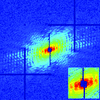issue contents
September 2015 issue

editorial
NEUTRON | SYNCHROTRON
New developments in neutron and synchrotron science and technology are discussed.
scientific commentaries
PHYSICS | FELS
The combination of cryogenic sample temperatures with three-dimensional coherent diffractive imaging for the case of whole frozen-hydrated cells is discussed in the light of theoretical predictions of the achievable resolution.
MATERIALS | COMPUTATION
Modern materials are often complex in the structure at mesoscale. The method of pair-density function (PDF) is a powerful tool to characterize mesoscopic structure, bridging short- and long-range structures.
research papers
MATERIALS | COMPUTATION
It is shown how normal-incidence X-ray total scattering can be used to obtain high-quality pair distribution functions from amorphous and crystalline thin films on much thicker substrates, allowing a range of studies of the local structure in film materials.
CHEMISTRY | CRYSTENG
Download citation


Download citation


The crystal structures of eight mono-methyl alkanes are solved from powder or single-crystal X-ray diffraction data, and optimized via DFT-D calculations.
CHEMISTRY | CRYSTENG
Download citation


Download citation


An extensive structural study on hydrogen and halogen bonding in co-crystals has helped clarify the competition and balance between them in a practical supramolecular synthesis.
MATERIALS | COMPUTATION
Pair distribution function analysis up to tens of nanometres allows probing of the structural changes in Ce1−xGdxO2−x/2 solid solutions at varying gadolinium concentrations. Dopant ions and oxygen vacancies form extended Gd2O3-like clusters (droplets) and nanodomains which, on increasing the Gd concentration, percolate and cause a long-range phase transformation. A general crystallographic rationale is presented which could be adopted to describe phase transformations in highly doped materials.
CHEMISTRY | CRYSTENG
Download citation


Download citation


Sixteen derivatives of the homologous series of bis(acrylamido)alkanes have been synthesized with the aim of systematic analysis of their crystal structures and their solid-state [2 + 2] reactivities. Seven out of the 16 found to have reactive alignments for solid-state [2 + 2] reactions yield dimers and polymers.
BIOLOGY | MEDICINE
This study focuses on the effects of the organic ligand 4-ethylresorcinol on the crystal symmetry and lattice dimensions of human insulin using powder X-ray crystallography.
BIOLOGY | MEDICINE
A new approach of using lipidic cubic phase as a carrier matrix for delivering soluble protein microcrystals for serial crystallography helps to dramatically reduce protein consumption. The structures of two soluble test proteins have been determined by this method using less than 0.1 mg of each protein.
CHEMISTRY | CRYSTENG
Download citation


Download citation


Fluorescence quenching by paramagnetic metal ions is attenuated in an Mn metal–organic framework (Mn-MOF) based on a pyrene linker. Based on solvent-dependent emission, the Mn-MOF is shown to serve as a solvent polarity probe. Further, sensing of nitroaromatics is demonstrated with a detection limit of ∼125 p.p.m. for TNT.
CCDC reference: 1057084
CHEMISTRY | CRYSTENG
Download citation


Download citation


A combination of single-crystal X-ray and neutron diffraction experiments are used to determine the electron density distribution in orthorhombic rubrene. The topology of electron density, NCI analysis and energetics of intermolecular interactions clearly demonstrate the presence of π⋯π stacking interactions in the crystalline state.
PHYSICS | FELS
Since its first experimental demonstration in 1999, coherent diffractive imaging (CDI) has been applied to image a broad range of samples using advanced synchrotron radiation, X-ray free-electron lasers, high harmonic generation and electrons. Here, the first experimental demonstration of cryogenic CDI for quantitative three-dimensional imaging of whole frozen-hydrated cells is reported. As a proof of principle, the three-dimensional mass density of the sub-cellular organization of a Neospora caninum cell is determined based on its natural contrast.
CHEMISTRY | CRYSTENG
Download citation


Download citation


Silyl capped aryl bis-ene–yne compounds and their derivatives possess a rich crystal chemistry: merotypism, polymorphism, polytypism, twinning and incommensurate modulation.
addenda and errata
BIOLOGY | MEDICINE



 journal menu
journal menu




 access
access



























